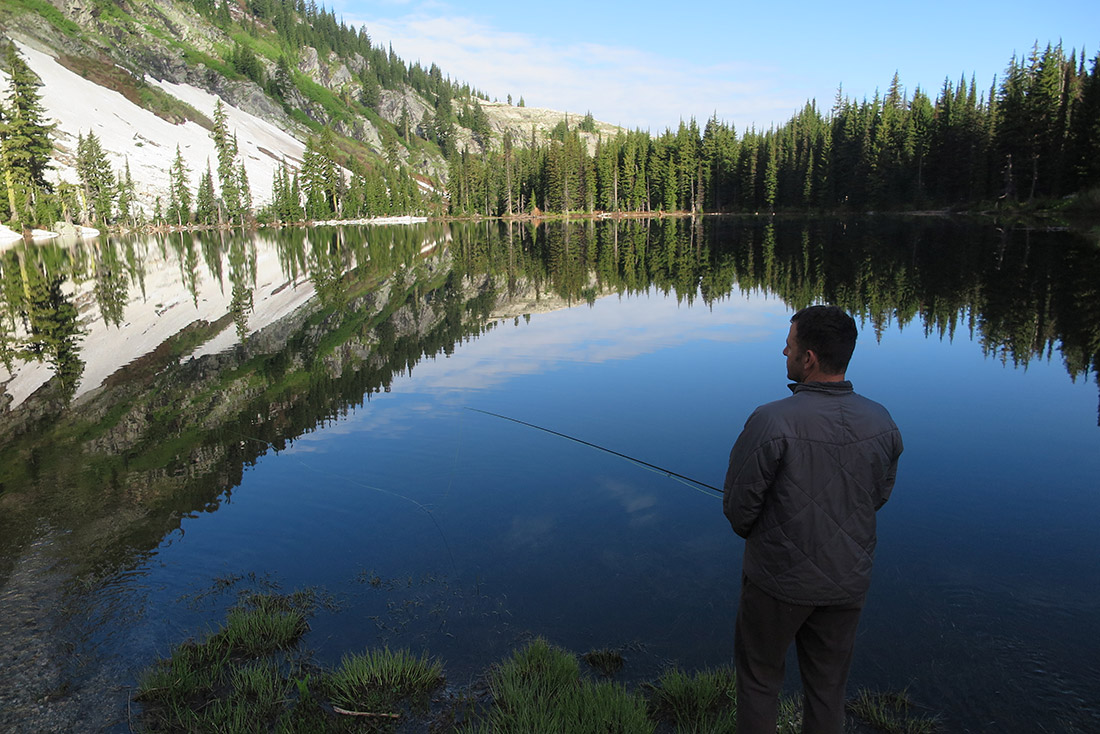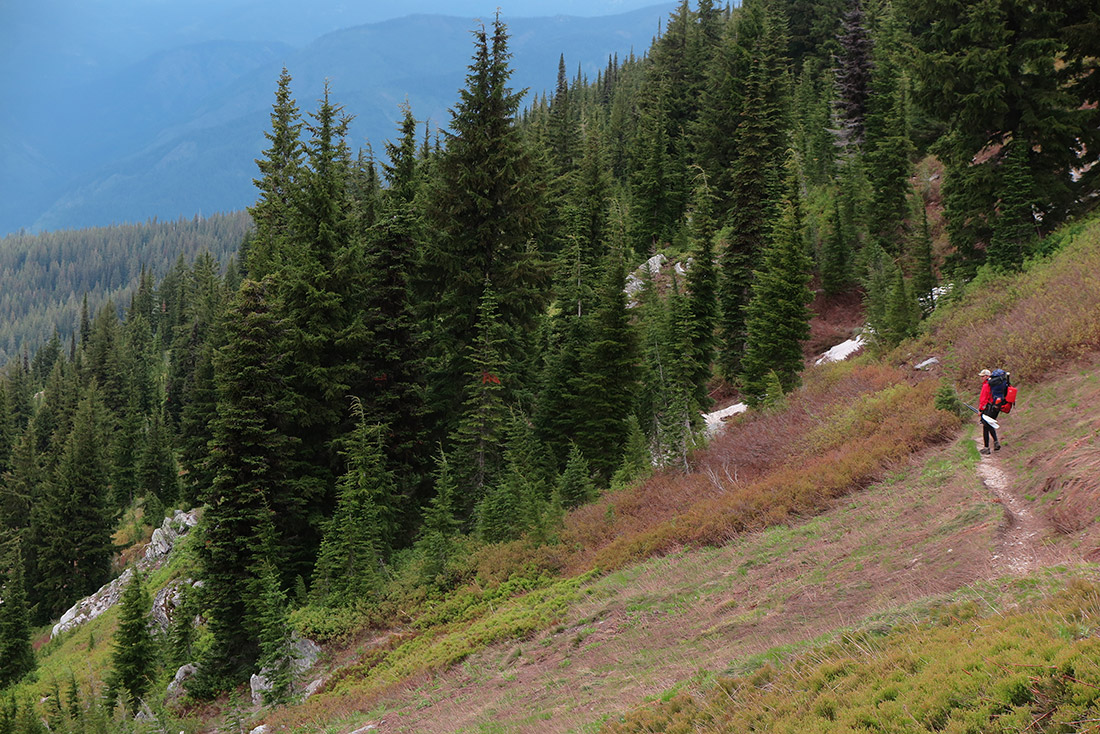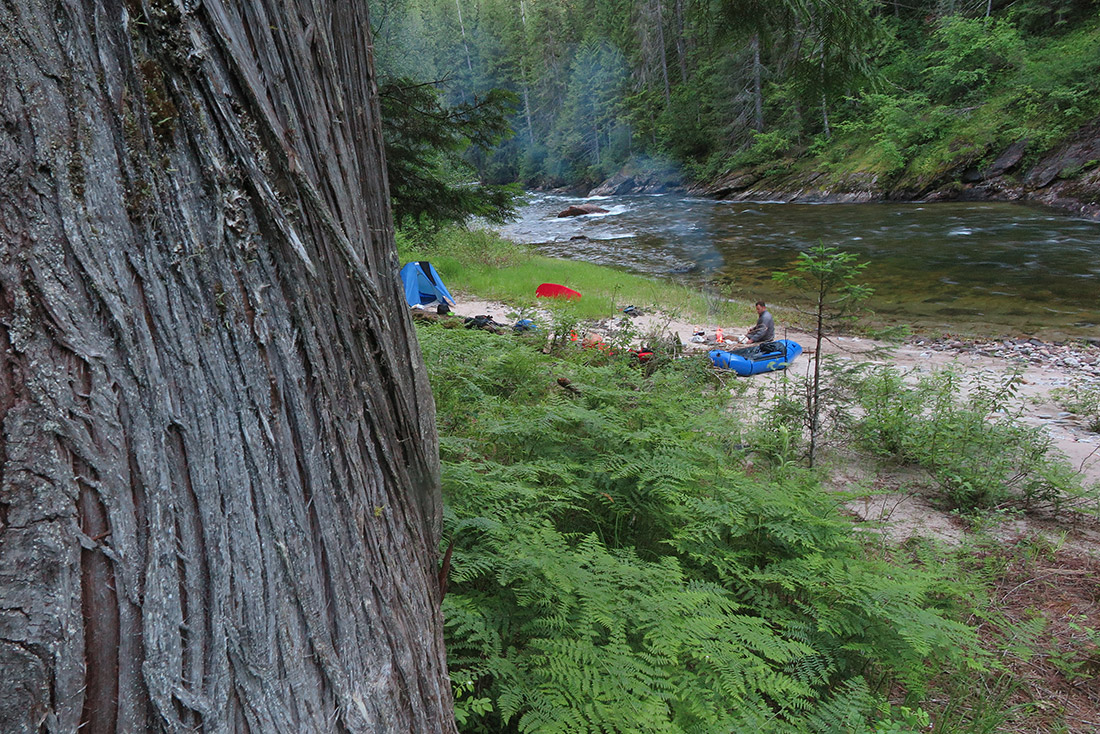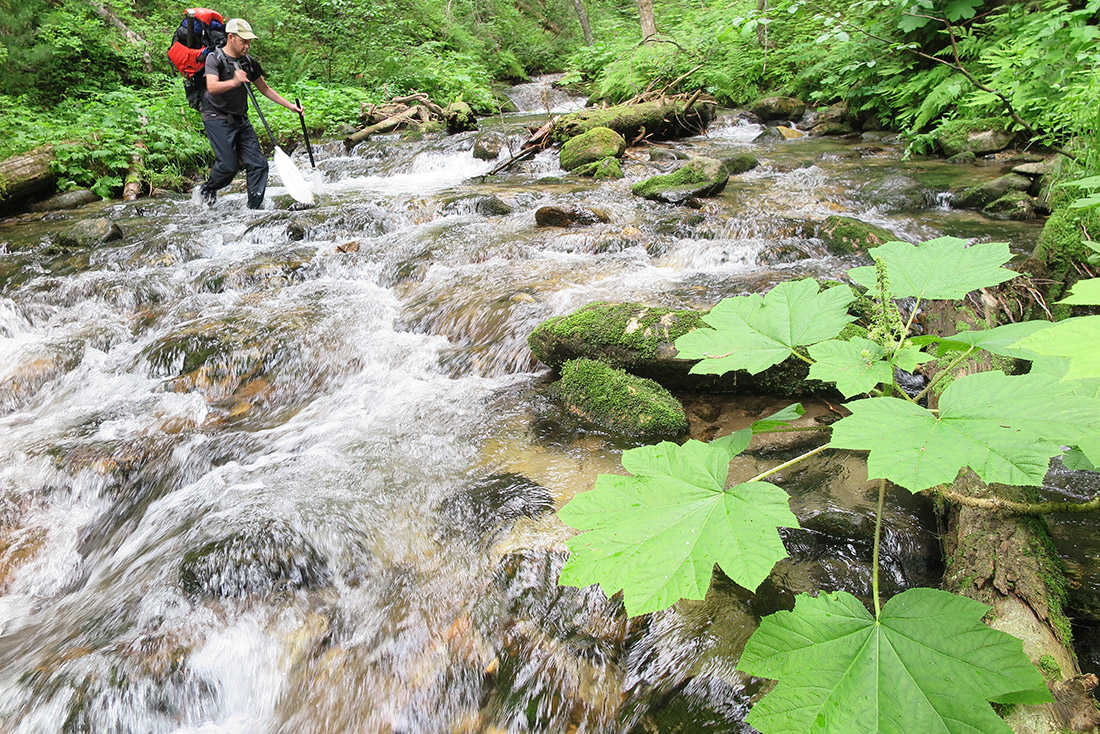By Tyler Williams; All photos by Tyler Williams
WE DROVE A ONE-LANE LOGGING ROAD, looking for a gap in the trees that would reveal some of the canyon below. Ahead, a man sat quietly on an ATV, waiting for us to pull alongside, a graying black lab perched on the seat behind him. Up front were two sealed plastic jugs, “for baiting bear,” he would tell us. His pants were greasy and his shoes tattered. On one hip he wore a large handgun, on the other, a smart phone. When I asked about a ridge we planned to bushwhack out of the canyon, he grinned. “You could do it,” he said, “but you wouldn’t want to.” Moments later we were at an overlook, blurry Google Earth images in hand, getting a geography lesson from our new friend, Roger, the local mountain man.
I’d come to this obscure corner of northern Idaho because it was the heart of the Clearwater Mountains, which is the center of a rich forest region that carries a variety of descriptive monikers: The Inland Empire Forest, The Coastal Disjunct Zone of the Northern Rockies, The Interior Montane Region. None of these are official titles, just as there are no hard boundaries to this forest land, but a rough geographic description would have it covering northwestern Montana, northern Idaho, northeastern Washington and southeastern British Columbia. Despite the region’s nebulous definitions, any tree lover will know when they’ve arrived there.
Two hours out of Missoula, it was obvious that Montana’s big skies were behind me when the highway I drove ran beneath walls of green 100 feet high, sheared back by the road crew to form a shaved strip through a carpet of forest. First there were stately grand firs and lacy western white pines, and then the trademark species of the region — western red cedar. Their sweeping limbs called me deeper into the empire, reaching outward like gothic angels’ wings. Finally, the hemlocks sneaked in, adding a dark, haunting element that was felt more than seen.

I spent summers as a kid amidst this forest, bringing stories of the wild woods back to the arid Southwest and my hiking companion, Bret. When he chose to live in the Pacific Northwest as an adult, I was quick to claim credit for the move, and eager to make annual visits. We’ve been adventuring in the dankest forests we can find ever since. This year, we met along the banks of Idaho’s big boisterous North Fork of the Clearwater River. The North Fork is the centerpiece for the Clearwater Refugium, one of several theories that attempt to explain how this West Coast environment got here, 375 miles from the coast. The refugium theory hypothesizes that mesic species, like hemlock and sword fern, migrated inland prior to the ice ages, then survived in the low-elevation canyons of the Clearwater River while the mountains above were mantled in ice. When the pleistocene ended, the moisture-loving plants climbed the slopes to new terrain and dispersed to wherever moisture would allow.
The refugium theory works for some of the inland habitat, but there is contradicting evidence. Red cedar (Thuja plicata) and western hemlock (Tsuga heterophylla) pollens have been found in lake sediments of the area up to 3,500 years ago, but no earlier. The ice ages came to a close more than 10,000 years ago. This leaves a 6,500-year gap, suggesting that these trademark species took hold through bird dispersal as the climate moistened just 35 centuries ago. Whatever the botanical evolution might be, today we are left with an uncommonly diverse mosaic of flora: three pines, three firs, two hemlocks, a spruce, a cedar, a larch, plus a handful of broadleaf trees and shrubs including birch, alder and maple. It’s a rich forest plopped between arid landscapes of the Intermountain West.
Our avenue through this cloaked country would lead down the Little North Fork of the Clearwater, a hidden drainage that promised extensive stands of old-growth forest, located one ridge north of the main North Fork. Mountain hemlock was the dominant species at 6,000 feet, as we hiked a high divide above the river canyon. Their dark trunks were dappled with moss, supporting feathery foliage that dangled over a hazy blue gap below. Looking west, there was a brightness indicating unbroken sunshine over eastern Washington, but our ridgeline was kissed by a mantle of cloud, producing a fine cool mist. It was June 23rd, and piles of snow still covered the trail.
Pacific air masses are wrung nearly dry by the Cascade Range, leaving some downwind locations with annual precipitation totals under 10 inches. But the storms regather to create another wet belt in the Clearwater Mountains. Most valley locations here receive about 40 inches of annual precipitation, roughly the same as Seattle. The mountains are even wetter.
The Clearwater cloud hovered as we pitched our tent beside a crystalline creek, lakeside. By morning I was sitting in emerging sunshine while Bret fished the mirror lake, a perfect reflection of hemlock and snow. We walked across open mountainsides of mountain ash and Rocky Mountain maple, gazing at lower slopes where a lime green carpet of cedar canopy was punctuated by soaring grand firs, dark and eminent. Soon our trail entered the woods — a pure stand of Englemann spruce. Their flaky trunks rose evenly from a carpet of green. It could’ve been any number of sprucey places from northern Canada to a Colorado mountainside, but when a steep bluff revealed a new grove of trees below, the scene was pure North Idaho. We were in the cedars.
The largest tree in North America east of the Cascade Range is a western red cedar. It grows over a cold spring-fed creek, among other giants, here in the Clearwaters. Although the species attains its greatest size in coastal rainforests and is revered by native peoples there for its many uses — house planks, canoe hulls, rope strands — the trees can be overlooked in the context of so many other big trees. In these interior forests, however, the cedars are king. No other tree besides California’s redwoods has the rot resistance of red cedar, which allows the trees to exceed 1,000 years of age and grow massive basal trunks in the process. These big cedars helped fuel the logging industry during the late 1800s, when northern Idaho led the nation in wood production. Even so, the girthy cedars weren’t the most favored timber tree in these woods, it was the white pine.
Western white pines (Pinus monticola) once dominated this landscape, an endless grove of tall perfectly straight trees, and to a logger’s eyes, perfectly suited for harvest. But, before these fields of conifers could be completely chopped down, most fell to the appetite of a parasite.
White pine blister rust (Cronartium ribicola), a Siberian fungus, landed in the port of Vancouver in 1910, and a decade later it was thriving in the pine forests of northern Idaho. By 1926, an eradication effort was commenced that focused on removing the rust’s host plant currant bush — from the entire landscape. Largely ineffective, the eradication program was finally abandoned in 1968, and by then most of the white pines were either dead from the rust or logged, or both.
Spotting a mature white pine these days is reason for excitement, so I was giddy when we arrived at the river. Several old pines rocketed skyward, arrow straight and hundreds of years old, survivors of the blister rust and escapees from the saw, elder trees that quietly lived in this natural canyon refuge, unreachable and unspoiled. The river glowed golden from yellow boulders beneath transparent flowing water. Happy to be unburdened of our packs, Bret and I blew up our pack rafts and started downstream. Around the first bend, a cow elk stood on shore, head down eating streamside grasses. We watched her for several seconds before she shot up with a startled look, then trotted along the river cobbles before crashing into the woods.
When a sandy beach backed by mature cedars appeared on the left, we knew we’d found camp. A huge log offered a drying rack for our wet gear, and an old fire ring sat a few feet from the water. We had a stove, but we cooked over a driftwood fire that night, burning our fingers and ingesting some ash, because it just felt like the appropriate thing to do, there among the 500-year-old trees. I wandered upstream to measure a big white pine. At two-and-a-half lengths of my encircling arms — 165 inches of circumference — it was a good healthy tree trunk, but hardly an adequate thickness to be supporting a tree that was 206 feet tall. The pine seemed almost delicate, a giant weed sprouting for the sky with child-like exuberance.
This old-growth forest is enduring, not just from blister rust and logging, but also fire. Low-intensity understory fires come through this habitat every 20 years on average. Big, hot, stand-replacing fires occur every 200 years. The most infamous of these was The Great Fire of 1910. Forests burned that year from New Mexico’s Gila to the Sierra Nevada and Cascades, and even the upper Midwest, but the epicenter of it all was northern Idaho. Two-and-a-half million acres burned here, much of it in a crown firestorm fueled by gale force winds. The town of Wallace, Idaho went down in flames while firefighter Ed Pulaski famously took refuge in a nearby tunnel with 50 of his troops, 46 of whom successfully escaped the disaster. Shocking news of “The Big Burn” (as coined in author Timothy Egan’s bestseller) helped generate public support for Teddy Roosevelt’s and Gifford Pinchot’s fledgling national forest service at a time when timber barons were gobbling up the land. Our national forest system of today owes much to these lush Inland Empire woods.
The Little North Fork is just south of the big burn, and just inside the boundaries of what became U.S. Forest Service land, only miles away from the stripped mountainsides belonging to the Potlach Corporation. It is a canyon lost in time, a relict of unmolested forest and a throwback wildland, lacking official wilderness designation but a de-facto wilderness nonetheless. Hunters, horse packers and the occasional backpacker or paddler like us comes here, but the place is principally the home of elk, moose, bear and trees. There are indications of man’s passing, but rarely a man to be found.
We got out of the river and picked up Roger’s horse trail, right where he said it was, beside his favorite fishing hole. Dodging through prickly head-high Devil’s club, we crossed a creek and started uphill, careful not to veer onto one of the beaten moose trails that led off the route. Up and up we went, past fresh bear scat and along a spine ridge with occasional views of the river far below, happily bouncing along in splashy runs beneath leaning cedar snags and drooping hemlocks.
I was lost in reverie when I noticed something was different. Direct sunlight shone on shrubby alders ahead of me and nearby fir trees were just 30 feet tall, forming an impenetrably thick hedge. We had entered a clear-cut. Just like that, wild nature was behind us, left below in its nurturing canyon. When we popped out on the logging road, the sun was setting over the rim of the canyon, illuminating blue humps of Clearwater country behind silhouettes of hemlock, hanging like a veil over the forgotten coast forests of the interior.
Tyler Williams is the author of “Big Tree Hikes of Sequoia Country–A Guide to the Giants.” To learn more, visit his website www.funhogpress.com.





